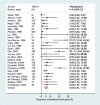Frequency of persistent tooth pain after root canal therapy: a systematic review and meta-analysis
- PMID: 20113779
- PMCID: PMC2832800
- DOI: 10.1016/j.joen.2009.11.007
Frequency of persistent tooth pain after root canal therapy: a systematic review and meta-analysis
Abstract
Introduction: Little is known about the frequency of persistent pain after endodontic procedures even though pain is a core patient-oriented outcome. We estimated the frequency of persistent pain, regardless of etiology, after endodontic treatment.
Methods: Persistent tooth pain was defined as pain present > or = 6 months after endodontic treatment. Endodontic procedures included in the review were pulpectomy, nonsurgical root canal treatment, surgical root canal treatment, and retreatment. Four databases were searched electronically complemented by hand searching. Two independent reviewers determined eligibility, abstracted data, and assessed study quality. A summary estimate of persistent all-cause tooth pain frequency was established by using a random-effects meta-analysis. Using subgroup analyses, we explored the influence of treatment approach (surgical/nonsurgical), longitudinal study design (prospective/retrospective), follow-up rate, follow-up duration, initial treatment versus retreatment, and quality of reporting (Strengthening the Reporting of Observational Studies in Epidemiology rankings) on the pain frequency estimate.
Results: Of 770 articles retrieved and reviewed, 26 met inclusion criteria. A total of 5,777 teeth were enrolled, and 2,996 had follow-up information regarding pain status. We identified 168 teeth with pain and derived a frequency of 5.3% (95% confidence interval, 3.5%-7.2%, p < 0.001) for persistent all-cause tooth pain. High and statistically significant heterogeneity among studies (I2 = 80%) was present. In subgroup analysis, prospective studies had a higher pain frequency (7.6%) than retrospectives studies did (0.9%). Quality of study reporting was identified as the most influential reason for study heterogeneity.
Conclusions: The frequency of all-cause persistent tooth pain after endodontic procedures was estimated to be 5.3%, with higher report quality studies suggesting >7%.
Copyright 2010 American Association of Endodontists. Published by Elsevier Inc. All rights reserved.
Figures
Comment in
-
Only a small percentage of patients experience persistent pain for more than 6 months after root canal therapy.J Evid Based Dent Pract. 2010 Dec;10(4):235-6. doi: 10.1016/j.jebdp.2010.09.001. J Evid Based Dent Pract. 2010. PMID: 21093808
-
How common is tooth pain after root canal treatment?Evid Based Dent. 2010;11(4):114. doi: 10.1038/sj.ebd.6400758. Evid Based Dent. 2010. PMID: 21170014
References
-
- de Oliveira BH, Nadanovsky P. The impact of oral pain on quality of life during pregnancy in low-income Brazilian women. J Orofac Pain. 2006;20:297–305. - PubMed
-
- Luo Y, McMillan AS, Wong MCM, Zheng J, Lam CLK. Orofacial pain conditions and impact on quality of life in community-dwelling elderly people in Hong Kong. J Orofac Pain. 2007;21:63–71. - PubMed
-
- Cohen LA, Harris SL, Bonito AJ, Manski RJ, Macek MD, Edwards RR, Cornelius LJ. Coping with toothache pain: a qualitative study of low-income persons and minorities. J Public Health Dent. 2007;67:28–35. - PubMed
-
- Woolfolk MW, Lang WP, Borgnakke WS, Taylor GW, Ronis DL, Nyquist LV. Determining dental checkup frequency. J Am Dent Assoc. 1999;130:715–723. - PubMed
-
- Anderson R, Thomas DW. `Toothache stories': a qualitative investigation of why and how people seek emergency dental care. Community Dent Health. 2003;20:106–111. - PubMed
Publication types
MeSH terms
Grants and funding
LinkOut - more resources
Full Text Sources
Miscellaneous



